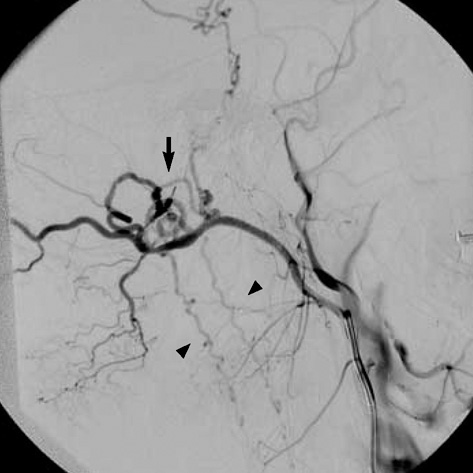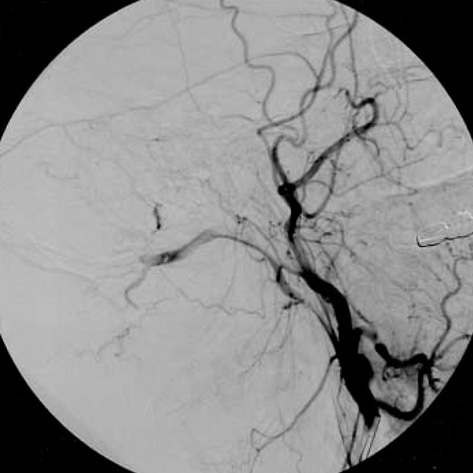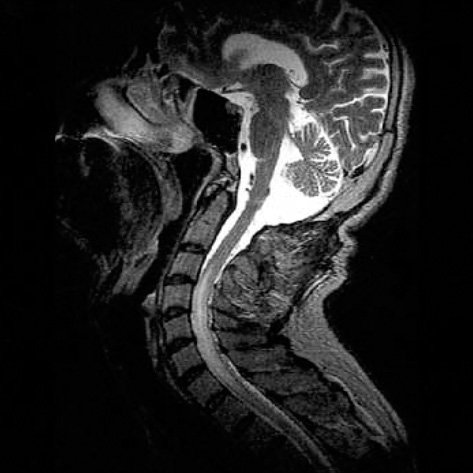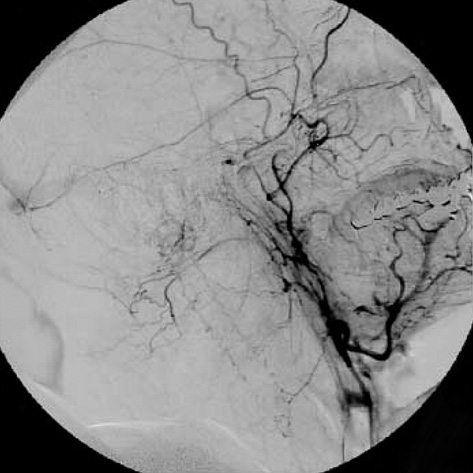J Korean Med Sci.
2006 Oct;21(5):958-962. 10.3346/jkms.2006.21.5.958.
Intracranial Dural Arteriovenous Fistula Draining into Spinal Perimedullary Veins: A Rare Cause of Myelopathy
- Affiliations
-
- 1Department of Physical Medicine and Rehabilitation, Medical Faculty of Ege University, Bornova-IZMIR, Turkey. yesim.akkoc@ege.edu.tr
- 2Department of Interventional Radiology, Medical Faculty of Ege University, Bornova-IZMIR, Turkey.
- KMID: 1781925
- DOI: http://doi.org/10.3346/jkms.2006.21.5.958
Abstract
- We report a rare case of progressive myelopathy caused by intracranial dural arteriovenous fistula with venous drainage into the spinal perimedullary veins. A 45-yr-old man developed urinary and fecal incontinence and muscle weakness in the lower limbs. Magnetic resonance imaging revealed brainstem edema and dilated veins of the brainstem and spinal cord. Cerebral angiography showed a dural arteriovenous fistula fed by the neuromeningeal branch of the left ascending pharyngeal artery. Occlusion of the fistula could be achieved by embolization after a diagnostic and subsequent therapeutic delay. There was no improvement in clinical condition. For the neurologic outcome of these patients it is important that fistula must be treated before ischemic and gliotic changes become irreversible.
MeSH Terms
Figure
Reference
-
1. Mullan S. Reflections upon the nature and management of intracranial and intraspinal vascular malformations and fistulae. J Neurosurg. 1994. 80:606–616.
Article2. Halbach VV, Higashida RT, Hieshima GB, Rosenblum M, Cahan L. Treatment of dural arteriovenous malformations involving the superior sagittal sinus. Am J Neuroradiol. 1988. 9:337–343.3. Cognard C, Gobin YP, Pierot L, Bailly AL, Houdart E, Casasco A, Chiras J, Merland JJ. Cerebral dural arteriovenous fistulas: clinical and angiographic correlation with a revised classification of venous drainage. Radiology. 1995. 194:671–680.
Article4. Awad IA, Little JR, Akarawi WP, Ahl J. Intracranial dural arteriovenous malformations: factors predisposing to an aggressive neurological course. J Neurosurg. 1990. 72:839–850.
Article5. Bret P, Salzmann M, Bascoulergue Y, Guyotat J. Dural arteriovenous fistula of the posterior fossa draining into the spinal medullary veins-an unusual cause of myelopathy: case report. Neurosurgery. 1994. 35:965–968.6. Pierot L, Chiras J, Meder JF, Rose M, Rivierez M, Marsault C. Dural arteriovenous fistulas of the posterior fossa draining into subarachnoid veins. Am J Neuroradiol. 1992. 13:315–323.7. Versari PP, D'Aliberti G, Talamonti G, Branca V, Boccardi E, Collice M. Progressive myelopathy caused by intracranial dural arteriovenous fistula: report of two cases and review of the literature. Neurosurgery. 1993. 33:914–918.8. Gobin YP, Rogopoulos A, Aymard A, Khayata M, Reizine D, Chiras J, Merland JJ. Endovascular treatment of intracranial dural arteriovenous fistulas with spinal perimedullary venous drainage. J Neurosurg. 1992. 77:718–723.
Article9. Gaensler EH, Jackson DE Jr, Halbach VV. Arteriovenous fistulas of the cervicomedullary junction as a cause of myelopathy: radiographic findings in two cases. Am J Neuroradiol. 1990. 11:518–521.10. Wrobel CJ, Oldfield EH, Di Chiro G, Tarlov EC, Baker RA, Doppman JL. Myelopathy due to intracranial dural arteriovenous fistulas draining intrathecally into spinal medullary veins. Report of three cases. J Neurosurg. 1988. 69:934–939.11. Woimant F, Merland JJ, Riche MC, de Liege P, Bertrand HJ, Bacri D, Haguenau M, Pepin B. Bulbospinal syndrome related to a meningeal arteriovenous fistula of the lateral sinus draining into spinal cord veins. Rev Neurol (Paris). 1982. 138:559–566.12. Mascalchi M, Scazzeri F, Prosetti D, Ferrito G, Salvi F, Quilici N. Dural arteriovenous fistula at the craniocervical junction with perimedullary venous drainage. Am J Neuroradiol. 1996. 17:1137–1141.13. Partington MD, Rufenacht DA, Marsh WR, Piepgras DG. Cranial and sacral dural arteriovenous fistulas as a cause of myelopathy. J Neurosurg. 1992. 76:615–622.
Article14. Rivierez M, Gazengel J, Chiras J, Dorwling-Carter D, Debussche D, Dubbs M, Kanaan H. Vertebro-dural arteriovenous fistulae of the foramen magnum with perimedullary venous drainage. Neurochirurgie. 1991. 37:179–184.15. Willinsky R, TerBrugge K, Lasjaunias P, Montanera W. The variable presentations of craniocervical and cervical dural arteriovenous malformations. Surg Neurol. 1990. 34:118–123.
Article16. Brunet E, Tache R, Lafitte F, Piotin M, Miaux Y, Martin-Duverneuil N, Chiras J. Intracranial dural arteriovenous fistula with perimedullary venous drainage. J Neuroradiol. 1998. 25:103–110.17. Wiesmann M, Padovan CS, Pfister HW, Yousry TA. Intracranial dural arteriovenous fistula with spinal medullary venous drainage. Eur Radiol. 2000. 10:1606–1609.
Article18. Brunereau L, Gobin YP, Meder JF, Cognard C, Tubiana JM, Merland JJ. Intracranial dural arteriovenous fistulas with spinal venous drainage: relation between clinical presentation and angiographic findings. Am J Neuroradiol. 1996. 17:1549–1554.19. Trop I, Roy D, Raymond J, Roux A, Bourgouin P, Lesage J. Craniocervical dural fistula associated with cervical myelopathy: angiographic demonstration of normal venous drainage of the thoracolumbar cord does not rule out diagnosis. Am J Neuroradiol. 1998. 19:583–586.
- Full Text Links
- Actions
-
Cited
- CITED
-
- Close
- Share
- Similar articles
-
- Cervical Myelopathy Caused by Intracranial Dural Arteriovenous Fistula
- Myelopathy due to Spinal Dural Arteriovenous Fistula: A Case Report
- Dural Arteriovenous Fistula at the Foramen Magnum with Holocord Myelopathy: Case Report
- Myelopathy Caused by Spinal Dural Arterio-Venous Fistula after First Lumbar Vertebral Body Fracture: A Case Report
- Surgical Treatment of Arteriovenous Malformations of the Spinal Cord








